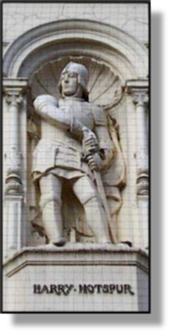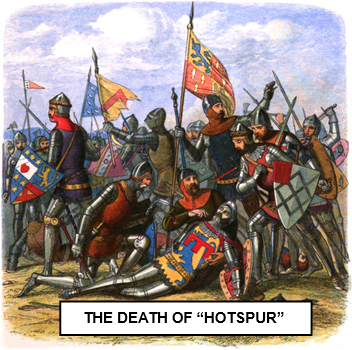


THE BATTLE OF SHREWSBURY 1403 (H4)
Including:
The Earl of
Northumberland
and Hotspur

xxxxxOn coming to the throne Henry IV was beset with problems, including an uprising in support of Richard II and a series of Scottish attacks across the border. In addition, as we have seen, in 1400 the Welsh nationalist leader Owen Glendower began a rebellion and, three years later, gained the support of the Percy family -
 xxxxxHenry IV was no sooner on the throne than he was beset with many problems. Not least among these was an uprising in support of Richard II, a series of Scottish attacks across the border, and a serious rebellion in Wales under the leadership of Owen Glendower. As we have seen, the Welsh revolt started in 1400, and became a real threat to the throne three years later when the Earl of Northumberland and his son Sir Henry Percy (known as “Hotspur” and illustrated here) issued a manifesto claiming that Henry had acquired his crown by fraud. They promptly raised a large force, and joined the Welsh and the Scots against the English crown.
xxxxxHenry IV was no sooner on the throne than he was beset with many problems. Not least among these was an uprising in support of Richard II, a series of Scottish attacks across the border, and a serious rebellion in Wales under the leadership of Owen Glendower. As we have seen, the Welsh revolt started in 1400, and became a real threat to the throne three years later when the Earl of Northumberland and his son Sir Henry Percy (known as “Hotspur” and illustrated here) issued a manifesto claiming that Henry had acquired his crown by fraud. They promptly raised a large force, and joined the Welsh and the Scots against the English crown.
xxxxxThis defection was the more surprising because, hitherto, the Percy family had been loyal supporters of the monarchy. The Earl had served Richard II in a number of important offices, and then given his backing to Henry, then Duke of Hereford, in the matter of the succession. Indeed, he also played a large part in the abdication of Richard II, and Henry’s success in gaining the English throne owed much to his support at that time. Andxit was Northumberland and his son who, meeting the Scots near Durham in 1402, won a resounding victory at the Battle of Homildon Hill, thus bringing much needed respite from the constant Scottish attacks into the northern counties.
 xxxxxHowever, it was this battle with the Scots and earlier conflicts along the border which were the major cause of their rebellion. Both were angered at the little reward they had received from the king in recognition of their services -
xxxxxHowever, it was this battle with the Scots and earlier conflicts along the border which were the major cause of their rebellion. Both were angered at the little reward they had received from the king in recognition of their services -
xxxxxIt was the son, Hotspur, who in June 1403 first raised the banner of revolt. Mustering a force in Cheshire, he marched to meet his father’s army, but was intercepted by Henry at Shrewsbury the following month. In the battle which ensued the rebels were defeated, and Sir Henry Percy was himself killed. His father’s troops arrived too late to take part in the fight. Had they done so, or had Henry not caught up with Hotspur before he joined forces with his father, then the outcome of this rebellion, along with history, might well have been very different.
xxxxxThe Earl of Northumberland then re-
xxxxxIn the years to come, the Percy family continued to play a prominent part in the affairs of state. One member was involved in the revolt known as the Pilgrimage of Grace; another was beheaded for supporting Mary Queen of Scots; and yet another was one of the chief conspirators in the Gunpowder Plot!
xxxxxIncidentally, Sir Henry Percy (knighted in 1377) was dubbed “Hotspur” by his Scottish opponents out of respect for his military prowess in keeping them on their side of the border. The character “Hotspur” features prominently in Shakespeare’s play Henry IV.



Acknowledgements
Hotspur: Statue in Northumberland Street, Newcastle-
H4-